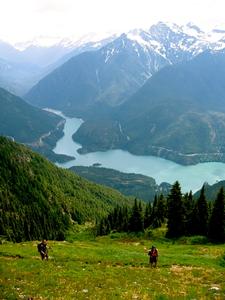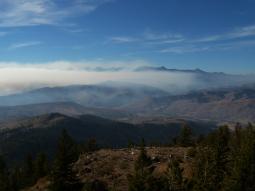By Andrew Allison and Aaron Hunter
By way of
introduction, Aaron and I are Habitat Restoration Technicians recruited by The
Mountaineers for an 8-day expedition survey to identify invasive and non-native
plant species in the Alpine Lakes Wilderness.
Our task was to supplement the volunteer efforts of the Alpine Lakes
Weed Watchers Program by surveying an iconic, high-priority trail: the entire
Pacific Crest Trail from Stevens to Snoqualmie Pass.
I have logged
multiple backpacking expeditions within the Appalachian Range and the Cascades,
and Aaron has spent time exploring the wilderness in Jamaica and the Olympic
Peninsula, but the experience before us became a trip all to itself. Armed with
five maps, four shoulders sagging under 65-pound packs, two GPS units, and one
fly rod, we set off from Stevens Pass for a 75-mile climb toward Snoqualmie.
Our first two days
were beautiful September gems: blue skies, warm sun, and no appreciable
humidity. We spent one night at Mig Lake and went as far as Deception Lakes on
day two. Tipped back in a Crazy Creek
chair, sipping hot coffee, and watching the Milky Way flow between towering
mountain peaks, it was hard to believe we were getting paid. On day three we excitedly encountered our
first non-native, a small patch of Wall Lettuce. We continued on to Deep Lake,
weathered an all-night thunderstorm, and began our fourth day in chilly but
fragrant wisps of early morning fog. Seven miles later we set camp at Waptus
River. Though peppered by another night of rain, we enjoyed the company of
local waterfowl, two stream-darters, and a fat brown crayfish.

Day five the weather
became menacing in earnest. We climbed to 5,530 feet under squalls of snow and
sleet with heavy winds, and pushed an 8-mile descent to the Lemah Creek valley
looking for shelter. The day proved the most physically challenging and the
most important for our work: northeast from Escondido Lake we discovered nearly
one acre of flowering hawkweed in a rocky meadow. Hawkweeds are difficult to key and the
yellow flowers concerned us – if the plants were indeed the non-native European
hawkweeds, the meadow needed prompt control methods in the coming months.
With three days
remaining in our adventure the sky opened to a brilliant blue. Dry and morale
improving, we climbed 3,000 feet from our campsite at Lemah Creek to the Parks
Lake Basin finding only one suspected non-native, a tall stalk of thistle that
looked suspiciously like the invasive Canada thistle. The following morning we woke to an early
winter preview. A quarter-inch of heavy frost lay on our tent, water in our bottles froze, and ice crept out a few feet from the lakeshore; truly an unexpected moment of alpine beauty. We concluded the trip with two sunny days cat-walking trail carved into cliff sides and scraped out of talus slopes. Smoke from a long season of forest fires filled valleys west and east, creating an unforgettable sunrise, and reminding us that not all wilderness areas were as tranquil as those we’d left behind.
.jpg) |
Overcoat Peak with Andrew
in foreground |
In total, we mapped
six locations of suspect and confirmed non-native species—a relatively good
prognosis for nearly 8 million square feet of survey area. GPS’s holstered, Aaron and I, our legs, and
our backs were unanimously pleased to see Betsy-Blue the faithful Volvo waiting
where we’d left her in the Snoqualmie Pass parking area. A whir of the engine,
a quick stop at Subway in North Bend, farewells in Issaquah, and the last step
of the expedition found its footing.














.jpg)








